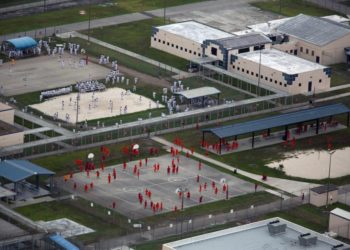In December 2023, I noticed something peculiar on satellite imagery of North Korea’s Pyongyang Sunan International Airport: An old Soviet cargo aircraft was being modified with structural pylons above its wings.
I assessed that these pylons could support a radar, which would turn this cargo aircraft into a flying early warning system capable of detecting missiles and enemy aircraft from hundreds of miles away. This assessment was confirmed on March 27, when North Korean leader Kim Jong Un toured the interior of the aircraft, offering the public its first glimpse of the completed system.
These surveillance capabilities will help North Korea keep an eye on South Korean and U.S. military assets moving about the peninsula. In the event of an attack, the aircraft could detect incoming cruise missiles long before they enter North Korean airspace.
But perhaps more importantly, this aircraft could also help North Korea finally crack a technological problem that has dogged it for decades: successfully developing warheads for its intercontinental ballistic missiles, or ICBMs, capable of reentering the atmosphere.
Airborne radar systems, developed in the 1950s, are common staples of advanced militaries because they offer two key benefits. First and foremost, they allow a country’s airborne forces to better see enemy aircraft. While the power of the radar must be somewhat limited to what can fit inside the aircraft, an airborne radar can fly at high altitudes, moving into positions best suited for tracking specific targets. As opposed to ground-based radar platforms, an airborne radar is also less constrained by the pesky curvature of the Earth and thus able to see low-flying aircraft, such as cruise missiles, at much farther distances than ground-based systems.
This last part is particularly a problem for North Korea, whose mountainous terrain makes it difficult to detect incoming cruise missiles. For instance, a North Korean ground-based radar in one valley may not see an enemy cruise missile in the next valley over. An airborne warning aircraft can look down into these valleys from above, giving North Korean leadership valuable warning time before those missiles hit their targets. Such an aircraft could also see ballistic missiles lifting off from South Korean launch sites from much farther away than ground-based radar.
Second, airborne radar platforms can be equipped with advanced communications technologies that allow its operators to network with other aircraft and share information about targets. North Korea is known to utilize its remaining tactical bombers as cruise missile carriers, so an aircraft equipped with radar and communications could inform tactical bombers in real time what they should be shooting at.
However, there are limitations to these benefits. North Korea has an extremely limited inventory of cargo aircraft suitable to be modified in this way, and so far it has only produced one such system. Because it cannot stay in the air indefinitely, this single aircraft cannot provide North Korea continuous coverage. Instead, it will likely fly intermittently and during crises and to keep an eye on military exercises conducted by South Korea or the United States.
North Korea has not operated an airborne early warning system before, but it’s unclear if this is due to a lack of interest or a lack of technological capability. It is possible that North Korea previously judged that these systems would be useless in a conflict due to U.S. and South Korean air superiority, and something caused that opinion to change. It is also possible that recent technology transfers from Russia have solved North Korea’s technological and production bottlenecks; Russian weapons have already been seen on North Korean ships, so this is distinctly possible but unproven.
In addition to making valuable contributions to Kim’s life expectancy, warning him of incoming decapitation strikes, an airborne radar could help North Korea perfect its burgeoning arsenal of ICBMs.
North Korea has been trying and struggling to build an ICBM since at least the 1990s, when the best it could muster was stitching together old Soviet designs. In the years since, North Korea has made immense strides and now ostensibly deploys some number of domestically made ICBMs with proven range capabilities.
But one area North Korean ICBMs have not proved themselves is in reentry vehicle technology. Nuclear warheads must be encased in heat-resistant materials to survive atmospheric reentry, but Pyongyang has not yet demonstrated a mastery of this technology. Over the past decade, North Korea has conducted 14 ICBM tests, and none has conclusively proved that the country has developed a reentry vehicle capable of withstanding reentry. Adm. Samuel Paparo, the head of U.S. Indo-Pacific Command, remarked as much last November, stating, “We’ve not yet seen that capability, but we just see continued testing towards that.”
A key hurdle in developing reentry vehicles has been North Korea’s geography. ICBMs have ranges of 6,200 miles or more, and North Korea, a relatively small country, is only about 620 miles across at its smallest point. More annoyingly for North Korea, it cannot launch out into the Pacific very often, as doing so requires launching over Japan, risking debris falling and killing Japanese civilians. Of North Korea’s 14 ICBM tests and numerous other long-range missile tests, only two have overflown Japan—prompting fear and agitation from Tokyo each time.
Because of this, North Korea has been forced to test its ICBMs at very short distances into the Sea of Japan, at around a 10th of its intended range. This situation isn’t ideal, as firing an ICBM at such short ranges puts unique stress on the reentry vehicle. On a normal trajectory over 6,200 miles, an ICBM is launched at about a 45-degree angle. As the warhead reenters the atmosphere and heads back toward the Earth, it does so gradually, with relatively low amounts of heat placing stress on the reentry vehicle. But when an ICBM’s range is shortened, it must be fired at steeper angles. This means that instead of reentering gradually, the warhead screams down through the atmosphere at an angle nearly perpendicular to the surface of the Earth, resulting in extremely high speeds and temperatures. For North Korea, this is not a terrific environment to be testing a novel reentry vehicle in: It is akin to learning to hit a baseball with the pitching machine set to its highest setting.
Making matters worse, North Korea likely has no way of monitoring if its reentry vehicles are working. Because of the curvature of the Earth, North Korean telemetry stations are likely losing track of ICBMs after they descend past around 87 miles above sea level, well before the Karman line denoting the beginning of the Earth’s atmosphere. This means North Korea likely only has a limited understanding of when its reentry vehicles are failing and why.
None of this means that the threat from North Korea’s ICBMs is zero—far from it. While North Korea’s reentry vehicles may be unreliable or possibly inaccurate, that does not guarantee they wouldn’t work. Still, North Korea’s failure to conclusively demonstrate its missiles’ reentry capability is damaging the credibility of its deterrent forces. If Kim cannot convince Washington that it can hold targets at risk, the United States may feel more willing to intervene on the peninsula.
A North Korean airborne radar can help solve these problems. Even if North Korea continues to limit itself to shorter-range tests, such an aircraft could loiter in the Sea of Japan and track reentry vehicles as they descend, collecting data on their accuracy and, if the warhead were to fail and break up on reentry, detect when and, perhaps, why
To a lesser degree, North Korea’s geography also creates problems for its cruise missile tests. North Korea has been flying its missiles in a figure-eight pattern right off its eastern coast to test the endurance of its systems. The problem with this arrangement is that such a pattern does not accurately reflect how the missile would operate in combat.
As discussed above, North Korea is very concerned about South Korean and U.S. cruise missiles coming in below its radar. Yet North Korea is simultaneously working on the same capabilities and has deployed the Hwasal series of conventional cruise missiles and the Pulhwasal series of nuclear cruise missiles.
Cruise missiles use several unique methods to guide themselves to the target, including look-down radar and cameras that match the surrounding terrain to pictures stored in the missile’s computers. This is a tricky technology to get working. The first version of the U.S. Tomahawk cruise missile used in Operation Desert Storm in 1991 had a success rate of roughly 50 percent. The United States has dramatically improved that success rate in subsequent decades, but for North Korea, a state with a much more limited technological base, this may be closer to its starting point.
These guidance technologies require a great deal of overland testing and data to function properly, and here an airborne radar could help. An airborne radar could follow and track a cruise missile test with much higher accuracy than ground-based radar. Russia has a special aircraft for this purpose—the Il-76LL “SKIP”—that uses the exact same aircraft type as the North Korean version.
In both testing and development, an airborne radar offers North Korea unique capabilities it could not achieve solely with ground-based stations. On the operational warfighting side, an airborne radar could see South Korean and U.S. missiles incoming, giving North Korea valuable warning time. On the missile testing side, an airborne radar capability could give North Korea the data it needs to perfect its ICBM reentry vehicle design, potentially shaving considerable time off development.
Of course, this system is not a silver bullet. It will not tell North Korea why its ICBMs’ heat shields are failing but merely offer clues about how and when failures occur. Lack of material for the heat shields or simple lack of understanding of those materials may still dog North Korea’s missile program if it cannot get materials from abroad. But an airborne radar platform can still give North Korea data it sorely needs—bringing it one step closer to finally mastering the world’s deadliest weapon.
The post This Technology Could Be a Game-Changer for North Korea appeared first on Foreign Policy.




